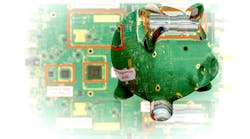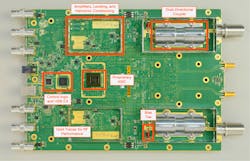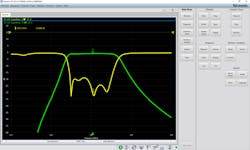Download this article in PDF format.
Vector network analyzers (VNAs) are test instruments considered almost synonymous with the RF/microwave industry. They are vital to the 50-Ω impedance matching of components through their scattering-parameter (S-parameter) measurements, and are rarely used outside of companies and laboratories working with RF/microwave equipment. Nonetheless, they have traditionally been “high-end” instruments, in terms of both performance and cost.
Many high-frequency designers can probably volunteer a story or two about waiting for their company’s VNA to be available for testing. Well, the wait is over, with the introduction of the quite affordable, yet precise, TTR500 two-port VNAs from Tektronix.
Priced at $12,000 USD for a 6-GHz VNA and $9,000 for a 3-GHz instrument, these VNAs literally bring S-parameters to the RF/microwave engineering masses—at least wherever there is a PC with a Universal Serial Bus (USB) 2.0 port to run the test software and control the TTR500. The measurement capability at these prices paves the way for affordable wireless products, such as for Internet of Things (IoT) and Fifth Generation (5G) wireless communications networks.
1. This unobtrusive little package houses a two-port vector network analyzer capable of making S-parameter measurements from 100 kHz to 6 GHz.
The TTR500 USB VNAs (Fig. 1) are available for two-port measurements from 100 kHz to 3 GHz or 100 kHz to 6 GHz, in both cases with better than 122-dB dynamic range. The two ports provide for forward- and return-loss measurements in the form of S21, S12, S11, and S22 parameters.
Although unimpressive in appearance, especially compared to their full-sized, rack-mount (and much more expensive) counterparts, they don’t skimp on performance with 0.008 dB root-mean-square (RMS) or less trace noise to enable that huge dynamic range. At the other end of the dynamic range, the VNAs provide as much as +7 dBm clean test source power (harmonics are ‒30 dBc or better), with test source power that can be adjusted over a broad range from ‒50 to +7 dBm. They even have a built-in bias tee for applying test signals and bias energy to active devices, such as transistors and amplifiers.
A Bird’s-Eye Vector-Vu
For a host of applications, two test ports provide sufficient measurement capabilities for many high-frequency component measurements, such as gain/loss, phase, group delay, and impedance matching. The analyzers are controlled by means of a USB connection to a PC running Tektronix’s VectorVu-PC software; the software is compatible with Microsoft Windows 7 and newer operating system (OS) software.
2. The rear panel of each TTR500 two-port USB VNA includes connectors for access to the internal 10-MHz reference oscillator and an input port to connect an external 10-MHz reference oscillator. Connecting to the latter will deliver better stability/phase-noise performance—when needed—than is possible with the internal reference oscillator.
Such reliance on a PC translates into the humble appearance of the TTR500 VNAs—they lack the display and wealth of control knobs of a traditional VNA—but it also accounts for their stunningly low price tags. The TTR500 VNAs actually have more control knobs and interconnections on their rear panels (Fig. 2), including access to the internal 10-MHz reference oscillator and a port for feeding an external 10-MHz reference oscillator to the TTR500, as well as bias connection points for the built-in bias tees.
The “guts” of the TTR500 measurement system are contained in the unobtrusive housings and its internal test board, which contains a specially designed application-specific integrated circuit (ASIC) with multiple receivers. The ASIC (Fig. 3) contains two channels of incident, reflected, and RF reference functions to provide the high-frequency signal processing to transmit and receive test signals through forward and reverse signal paths of a device under test (DUT).
3. This ASIC is one of the keys to achieving full two-port S-parameter measurements in a package as small as the TTR500.
The “smarts” can be found in the controlling computer and the VectorVu-PC software, which provides a straightforward graphical user interface (GUI) for intuitive control of two-port VNA measurements. The firm also provides a number of instructional videos on its website, to help users get started with measurements such as broadband gain as a function of frequency.
The VectorVu-PC software provides all of the analysis capabilities of a full-sized VNA, including Smith chart displays of S-parameter amplitude and phase as a function of impedance (Fig. 4). For circuit designers, the VectorVu-PC software can generate .sNp Touchstone-compatible files for use in a commercial computer-aided-engineering (CAE) simulation program. The software should run on a fairly robust PC, with a Core i7 microprocessor from Intel with 8-GB memory—the recommended computing engine—and minimum of a Core i3 microprocessor with at least 8-GB memory.
4. The TTR500 USB VNAs are controlled by a USB-equipped PC running VectorVu-PC measurement software. The combination is capable of a 122-dB dynamic range to 6 GHz with performance comparable to full-sized, rack-mount VNA systems.
These USB VNAs and the VectorVu-PC software make S-parameters affordable and, in so doing, should make measurements like gain, phase, and VSWR with frequency accessible for a growing number of RF/microwave engineers and their applications. The VNAs enable students and industry professionals to perform two-port S-parameter measurements without waiting for access to the single VNA system at a particular location.
The TTR500 VNAs are backed by a complement of accessories, including calibration kits, coaxial adapters, phase-stable measurement cables, rack-mount kits—even a carrying case to make it easier to transport the VNA. Each of the TTR500 VNAs measures just 8.125 × 11.25 × 1.75 in. (206.4 × 285.8 × 44.5 mm) and weighs only 3.5 lbs. (1.59 kg). They are small enough to fit almost anywhere, yet still possess the performance needed for troubleshooting, design support, and even classroom instruction. The minuscule price tags all but ensure that those working on the growing number of “commodity” wireless applications, such as impedance matching of antennas for IoT wireless sensors, will find a two-port VNA in their price range.
Tektronix Inc., P. O. Box 500, 14150 SW Karl Braun Dr., Beaverton, OR 97077; (800) 833-9200, www.tek.com.





